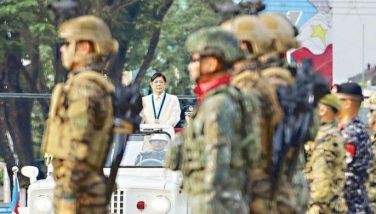SWS: 44% feel worse off, optimism low
April 20, 2004 | 12:00am
The Social Weather Stations (SWS) indicators for the economy in March 2004 are still gloomy, with 44 percent of the electorate saying that quality of life worsened from a year ago, only 17 percent saying it got better, and 39 percent feeling it remains unchanged.
Only 26 percent of voters are optimistic that their quality of life will improve after a year, while 18 percent expect it to worsen, 33 percent say it will not change, and 23 percent don’t know.
Among voters who also head their households, 7.4 percent say that their families experienced hunger at least once in the past three months, and 58 percent rate their families as poor.
Although a gap of losers over gainers is common, the gap is presently 27 points, up from 22 points in November 2003, and has been over 20 points continuously since 1998.
It is common for optimists to outnumber pessimists, but the spread is now only eight points against 14 points last November, and has been below 20 points in the entirety of both the Estrada and Arroyo administrations, with the exception of their first month of office.
Pessimism is even dominant in Mindanao and the Visayas, but is offset by optimism in Metro Manila and the balance in Luzon.
The gap between losers and gainers, on the other hand, is found in the four major areas of the country.
The SWS March 2004 survey was carried out among registered voters, of whom only those who were household heads were asked about hunger and poverty.
Among household heads, 2.8 percent said their families experienced hunger often or always in the past three months, which is defined as severe hunger, while 4.6 percent said they experienced it once or a few times, which is moderate hunger, adding up to 7.4 percent of a projected 16.3 million Filipino families as having suffered hunger recently.
The 2004 QI hunger rate is below the 9.4 percent of the last quarter, but above the 5-6 range of the first three quarters of 2003.
Fifty-eight percent of the household heads rated their families as mahirap or poor compared to 64 percent a quarter ago.
Self-rated poverty has ranged between 53 percent and 66 percent during the Arroyo administration, and was between 54 percent and 65 percent during the Estrada period.
When the household heads were asked how much monthly budget for home expenses they would need in order not to consider themselves poor, the median responses were P15,000 in Metro Manila, P10,000 in the balance of Luzon, P10,000 in the Visayas, and P7,000 in Mindanao.
The median divides the lower half of the poor from the upper half of the poor.
The survey for the first quarter 2004 Social Weather report used face-to-face interviews over March 21-29, 2004 of a national sample of 1,400 statistically representative registered voters, with quotas of 300 in Metro Manila, 250 in Luzon north of Metro Manila, 250 in Luzon south of Metro Manila, 300 in the Visayas, and 300 in Mindanao.
This sample was found to have 98 household heads in Metro Manila, 211 in the balance of Luzon, 139 in the Visayas, and 136 in Mindanao.
The questions on gaining/losing and optimism/pessimism were asked of the full sample, and have error margins of four percent at the national level, seven percent for the balance of Luzon, nine percent for Visayas and Mindanao, and 10 percent for Metro Manila.
The items described in this release were not commissioned, but are regularly included in the Social Weather surveys, which are supported by subscribers, who have no proprietary rights over the data.
SWS has regularly surveyed poverty, gaining/losing and optimism/pessimism since 1986, and hunger since 1998.
Only 26 percent of voters are optimistic that their quality of life will improve after a year, while 18 percent expect it to worsen, 33 percent say it will not change, and 23 percent don’t know.
Among voters who also head their households, 7.4 percent say that their families experienced hunger at least once in the past three months, and 58 percent rate their families as poor.
Although a gap of losers over gainers is common, the gap is presently 27 points, up from 22 points in November 2003, and has been over 20 points continuously since 1998.
It is common for optimists to outnumber pessimists, but the spread is now only eight points against 14 points last November, and has been below 20 points in the entirety of both the Estrada and Arroyo administrations, with the exception of their first month of office.
Pessimism is even dominant in Mindanao and the Visayas, but is offset by optimism in Metro Manila and the balance in Luzon.
The gap between losers and gainers, on the other hand, is found in the four major areas of the country.
Among household heads, 2.8 percent said their families experienced hunger often or always in the past three months, which is defined as severe hunger, while 4.6 percent said they experienced it once or a few times, which is moderate hunger, adding up to 7.4 percent of a projected 16.3 million Filipino families as having suffered hunger recently.
The 2004 QI hunger rate is below the 9.4 percent of the last quarter, but above the 5-6 range of the first three quarters of 2003.
Self-rated poverty has ranged between 53 percent and 66 percent during the Arroyo administration, and was between 54 percent and 65 percent during the Estrada period.
When the household heads were asked how much monthly budget for home expenses they would need in order not to consider themselves poor, the median responses were P15,000 in Metro Manila, P10,000 in the balance of Luzon, P10,000 in the Visayas, and P7,000 in Mindanao.
The median divides the lower half of the poor from the upper half of the poor.
This sample was found to have 98 household heads in Metro Manila, 211 in the balance of Luzon, 139 in the Visayas, and 136 in Mindanao.
The questions on gaining/losing and optimism/pessimism were asked of the full sample, and have error margins of four percent at the national level, seven percent for the balance of Luzon, nine percent for Visayas and Mindanao, and 10 percent for Metro Manila.
The items described in this release were not commissioned, but are regularly included in the Social Weather surveys, which are supported by subscribers, who have no proprietary rights over the data.
SWS has regularly surveyed poverty, gaining/losing and optimism/pessimism since 1986, and hunger since 1998.
BrandSpace Articles
<
>
- Latest
- Trending
Trending
Latest
Trending
Latest
Recommended

































